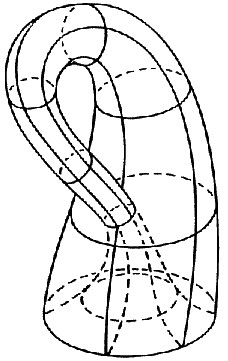The original question was: Assuming we had four (or more) spatial dimensions in which to freely move around, like say a 4+1 dimensional universe, how might one extend our 3+1 dimensional physics to that universe?
Side note: When someone says “3+1 dimensions”, what they mean is “3 regular space dimensions, and one time dimension” which is exactly the situation we live in (apologies to our pan-dimensional readers).
Physicist: Right off the bat, more dimensions means more freedom of movement. One of the more mundane effects of that is that in 4 dimensional space there’s an extra direction you can move and/or fall over in. So if you want to build a working bar stool you’d need at least 4 legs instead of just 3. In fact, in D-dimensional space bar stools need at least D legs, or they’ll fall over. Just one of the subtle economic effects of higher dimensional living.
You’d also find that in 4 or more dimensions, you’d be able to do a lot of tricks impossible in 3 dimensions, like creating Klein bottles or (equivalently) taping the edges of two Möbius strips together. Sailing knots could take on stunning complexities. In fact, they’d need too! All of the knots that work in 3 dimensions fall apart immediately in 4.
Most physical laws are already written in a dimension-free form. For example, in Newton’s second law, ,
and
are both vectors, but they can be vectors in any number of dimensions. So you can use
for objects on a line (1-D), on a table-top (2-D), in space (3-D), or whatever (whatever-D).
There are some laws that are usually written in a 3-D form, but that’s generally a matter of convenience more than necessity. For example, we talk about the “angular momentum vector”, which is defined to be perpendicular to the plane of rotation. It’s convenient because in three dimensions there’s always exactly one perpendicular direction to a plane, whereas in 4 dimensions (for example) there are 2.

In 3-D we can formulate laws about spinning things in terms of the one direction that isn’t spinning (h), the “axis of rotation”. But we can always formulate laws in terms of the two directions that are spinning, regardless of dimension.
This is pretty easy to fix and generalize, it just becomes a little more difficult to work with. All that said, while our physical laws can be generalized to any number of dimensions, the manifestation of those laws are wildly different. So, living in higher dimensions would be pretty alien.
Based on our understanding of gravity (gained from studying this podunk universe), gravitational force should drop by , where D is the dimension and R is the distance between the objects in question. It so happens that because of the nature of orbits, a stable orbit can only exist in 2 or 3 dimensions.

The “effective potential” representing the balance between the gravity and centrifugal forces of an orbiting object. Orbits can be stable in 2 and 3 dimensions. In all other dimensions planets and moons will always either spiral in or fly away. Shown here is the potential energy from gravity and the centrifugal force combined. If there’s a “cup” you can form a “bound orbit” in it.
In 4 or more dimensions orbits are always unstable, and in 1 dimension the idea of an orbit doesn’t even make sense.
Most physicists consider light to be native to only 3 dimensions, because light is an EM wave and it’s direction of propagation is perpendicular to both its Electric and Magnetic fields. (Fun fact: the direction that light points is called the “Poynting vector“, after John Henry Poynting. Life’s funny.) In 4 or more dimensions this direction isn’t unique, and in two dimensions there’s no direction at all. However, you can express EM waves just in terms of “E” in any dimension without problem.
Assuming light can exist in higher dimensions, it would behave very strangely. Sound waves too. In odd dimensions other than 1 (3, 5, 7, …) waves behave the way we normally see and hear things: a wave is formed, it moves out, and it keeps going. However, in even dimensions, and 1 as well, (1, 2, 4, 6, …) waves “double back” on themselves. You can see this in ripples on the surface of water (2-D waves). Ripples are more complex than just a ring; the entire circle within the ripples is disturbed.

In even dimensions (like the 2-D surface of water), waves propagate in a more complex way than we’re used to. Instead of a simple pulse, you get an “area filling” wave.
If you set off a firecracker in 3, 5, 7, etc. dimensions, then you’ll see and hear the explosion for a moment, and that’s it. If you set of a firecracker in 4, 6, 8, etc. dimensions, then you’ll see and hear the explosion intensely for a moment, but will continue to see and hear it for a while. For light the effect would be fairly subtle, except for extremely long-distance effects, like somebody reflecting a bright light off of the moon. You probably wouldn’t notice the effect day-to-day. However, it would ruin the experience of sound. In 4 dimensional space the firecracker, even in open air, would sound like thunder; loud at first, and leading into a drawn out boom. It may not even be possible to understand people when they speak.
All the fundamental particles should still exist, but how they interact would be pretty different. Which elements are stable, and the nature of chemical bonds between them, would be completely rearranged. Some things would stay the same, like electrons would still have two spins (up or down). But atomic orbitals, which are determined by spherical harmonics (which in turn are more complicated in higher dimensions), would generally be able to hold more electrons. As just one example (for our chemistry-nerd readers), you’ll always have 1 S orbital in every energy level, but in 4 dimensions you’ll have 4 P orbitals in each energy level, instead of the paltry 3 that we’re used to. This messes up a lot of things. For example, in 4 dimensions Magnesium would be a noble gas instead of a metal. Every element after helium would adopt weird new properties, and the periodic table would be longer left-right and shorter up-down.
So, while the laws of physics are actually the same, if you lived on a four-dimensional Earth in a four-dimensional universe you’d find that (among other things): your bar stool may need an extra leg, Earth wouldn’t be able to orbit anything, you’d never be able to hear anything crisply, and the periodic table of the elements would be seriously rearranged.








72 Responses to Q: What would life be like in higher dimensions?